Want to take your smartphone videos to the next level? Who says you need fancy equipment to create cinematic masterpieces? With just your trusty pocket device and a dash of creativity, you can shoot visually stunning films that pack a serious punch.
From iconic directors like Steven Spielberg to up-and-coming YouTubers, anyone with passion and grit can make movie magic. So let’s transform that everyday phone into a powerful filmmaking tool!
1. Light up Your Shots
Lighting can make or break any video. Learn to wield this essential ingredient and instantly give your clips a professional polish.
Embrace Natural Light
Before breaking out artificial lighting gear, look to the natural world around you. The diffuse, golden glow near sunrise or sunset creates a warm, welcoming mood perfect for human interest stories. Harness the sun’s rays during the magic hour just before dusk for an ethereal look as shadows lengthen.
When shooting outdoors, watch out for patches of harsh daylight that cause blown-out highlights or shadows. Softening intense sunlight using a semi-sheer curtain or white fabric as a DIY diffuser helps balance contrast.
Play with Shadows and Silhouettes
Contrary to popular belief, shadows aren’t the enemy! When used intentionally, strong shadows inject your scene with drama and depth. Try positioning your subject near a window for striking backlighting. Or embrace silhouette shots for artistic flair.
DIY Lighting Hacks
With some simple DIY tricks, you can craft homemade lighting solutions:
- Repurpose household flashlights or bike lights as makeshift spotlights.
- Use fairy or Christmas lights for creative effects.
- Reflect light from a computer, TV, or phone screen to gently illuminate your subject’s face.
Follow basic three-point lighting techniques, keeping extra lights small and mobile. Let your imagination run wild!
2. Frame Shots Like the Pros
Even more than gear, cinematic framing separates the amateurs from the big dogs. Learn sleda few rules of thumb for impactful, professional-looking composition.
Lead Viewers Into the Frame
Use leading lines like roads, fences, even trees to guide the viewer’s eye directly to your main subject. Position important elements near intersection points in the frame according to the rule of thirds for optimal placement.
Get Intimate With Close-Ups
Channel Scorsese and get intimate! Cropping tight focuses attention and evokes emotion. When filming people, zero in on their eyes, detail shots of hands or feet, or small gestures that reveal what’s not said in dialogue.
Remember to leave some breathing room though. Totally cropping out hair, chins, or other body parts feels uncomfortably claustrophobic.
Mind the Headroom and Dead Space
Pay attention to “dead space” or excess areas at the top and bottom of the frame that add no value. Position subjects slightly low or high instead of dead center vertically to create balanced headroom and foot room.
3. Move the Camera for Motion
Static shots quickly bore modern viewers. Infuse your films with energy using careful camera motion techniques.
Invest in Camera Stabilization
Shaky footage screams “amateur!” Before attempting ambitious camera moves, ensure stabilization with smartphone accessories like tripods, handles, or motorized gimbals. This allows sweeping cinematic shots without chaos.
Transition Between Shots Smoothly
Great films employ thoughtful transitions linking scenes. Whether moving from a wide establishing shot to close-up, or across significant time jumps, maintain continuity. Try subtle zooms, slow fades rather than jarring cuts, or slides/reveals.
Harness the Power of Movement
Remember, motion conveys emotion! A slow pan upwards reveals towering buildings, evoking wonder in viewers. As your subject walks away, handheld follow shots heighten longing. Choose angles and camera motion deliberately to progress the story.
4. Enhance Videos With Sound
Sound and cinematography join forces for maximum impact. Elevate your homemade films with audio polish using these tips:
Incorporate Natural Sounds
Ambient audio like park chatter or raindrops boosts realism better than canned sound effects. Let your phone’s microphone capture laughter, wind through trees, or dogs barking to boost immersion.
Set the Right Musical Mood
Scoring your video? Stocks sites like Artlist and Bensound offer plenty of high-quality, royalty-free tunes. Just ensure the music suits your desired tone.
Got copyright concerns? Check licenses carefully or use lesser-known artists. When in doubt, stick to public domain classical pieces.
Strategic Silence Goes a Long Way
Sometimes sound design means knowing when NOT to use audio. Allow quiet scenes to unfold using only visual storytelling for maximum dramatic anticipation.
5. Elevate With Smooth Editing
At its core, cinematography blends captured footage and audio into a cohesive visual narrative. Strong editing binds these pieces together seamlessly.
Keep Viewers Engaged
In our distraction-prone digital era, the editor’s most vital job becomes maintaining audience focus. Social media primed viewers start tuning out around the two-minute mark for amateur content. Craft a tight story patients won’t itch to click away halfway through.
Trim the Fat Ruthlessly
Be your own harshest critic! As you review and arrange clips, cut anything that distracts from your core story: shaky or over/underexposed shots, rambling sections where nothing happens, disjointed audio.
Remember Chekhov’s razor: don’t include distracting elements unless absolutely necessary. Every frame should move the narrative forward.
Transition Smoothly
Just like scene changes, clean audiovisual transitions between clips boost flow. Avoid jarring jump cuts. Use simple dissolves, fades, wipes and match action seamlessly via movement or dialogue.
The Final Cut: Tell a Story!
Ultimately, people connect with stories that resonate emotionally. So choose a focus for your film that intrigues, whether comedy, tragedy, injustice, or inspiration. Develop an arc that taps into universal human truths.
If you lead viewers on this journey, they’ll forgive imperfect lighting or amateur shot sequences. Great films shine through not because of slick equipment, but the potency of their narrative.
So grab your smartphone, lean into creativity rather than hardware limitations, and let your distinctive voice shine! You may be surprised what cinematic gems you produce.
A Note on Ethics
While chasing filmmaking dreams, we also carry responsibility for our media’s impact. Always remain ethical by respecting locations and participants. Seek enthusiastic consent and avoid reinforcement of harmful stereotypes.
Focus first on sharing stories that uplift rather than harm. If we embrace this mindset, visual media offers a powerful tool for social good.
















Add Comment